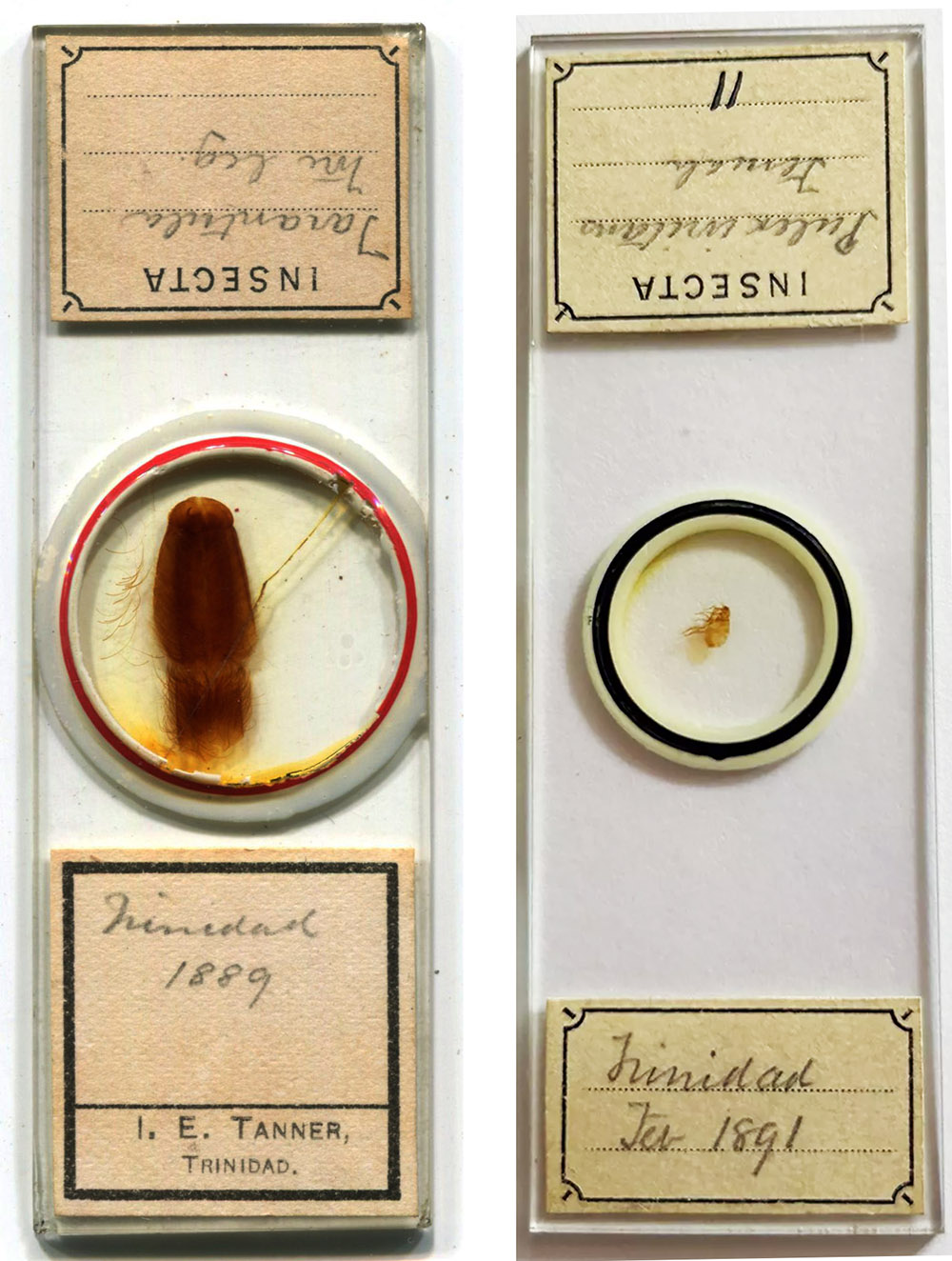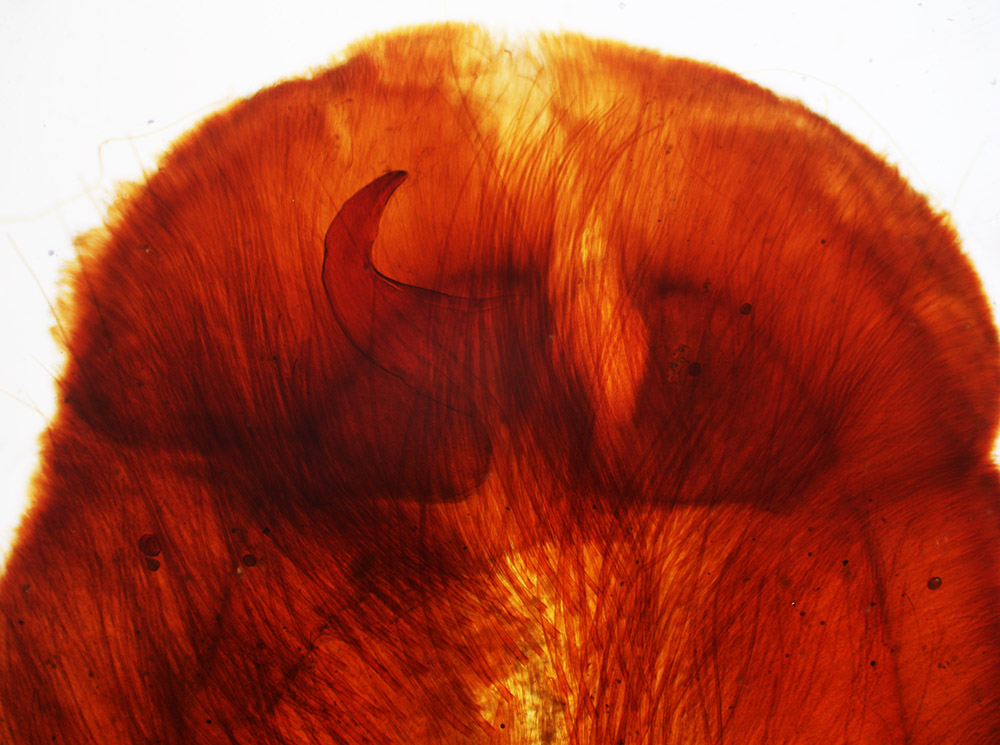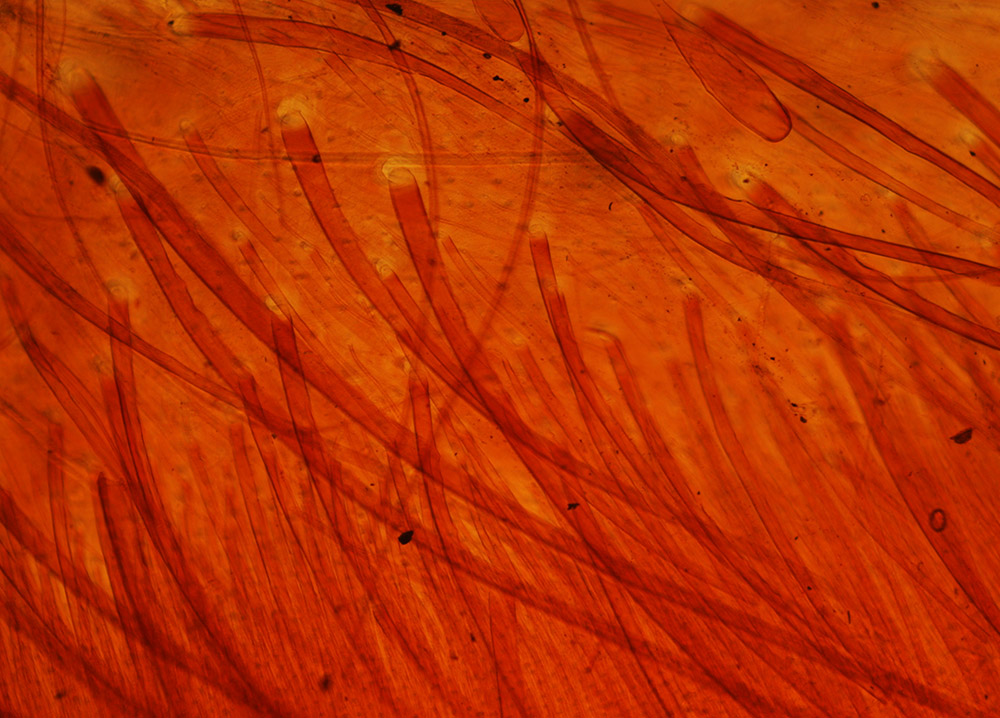John Edward Tanner, 1834 – 1906
“I. E. Tanner”
by Brian Stevenson
last updated September, 2024
John Tanner was civil engineer for the British government, stationed in France, Crimea, India, and Trinidad. A small number of microscope slides are known from his days in Trinidad, where he was a member of the Trinidad and Tobago Field Naturalists’ Club (Figure 1). Tanner’s slides are labeled “I.E. Tanner”, the initials “J.” and “I.” were often used interchangeably in the 1800s (as a common example, Johann D. Möller often labeled his slides “I.D. Möller”.

Figure 1.
(Left) “Tarantula fore leg”, mounted in 1889 by John E. Tanner. (Right) “Flea, Pulex irritans, female”, unsigned by likely mounted by J.E. Tanner in Trinidad, 1891. From the author's collection or adapted for nonprofit, educational purposes from an internet auction site.

Figure 2.
Claw on the tip of a tarantula’s foreleg, mounted by J.E. Tanner (See Figure 1). Imaged with 3.5x objective lens, a C-mounted digital SLR camera, and combined transmitted and top lighting, on a Leitz Ortholux II microscope.
John Edward Tanner was born on born on January 20, 1834, in Speen, Berkshire. He was the third of at least six children of John and Mary Tanner. Our microscopist’s father was a solicitor.
According to a 1907 obituary, Tanner “was educated at Putney College, and obtained his practical training at the works of Messrs. Simpson and Company. Subsequently he served a pupilage to Sir Charles Hutton Gregory … who appointed him in 1853 an assistant to the late Mr. Thomas Olinthus Donaldson, then engaged in railway construction in the South of France".
“In 1855 Mr. Tanner proceeded to the Crimea, and joined the Army Works Corps before Sebastopol as an Assistant-Superintendent. Upon the termination of the war Mr. Tanner was appointed an Assistant Engineer on the Indian Guaranteed Railways in Sind and the Punjab, and arriving in India upon the eve of the outbreak of the Mutiny (ca. 1857), he served with a body of European Volunteers until the danger was at an end. He was later appointed Engineer in charge of the Sutlej division of the Delhi Railway, including the Sutlej Bridge.”
Tanner married a woman named Mary on July 15, 1867, in Kasauli, Bengal. She died on November 6, 1868, in Lahore.
Quoting again from the obituary, “In 1871, at the request of the Colonial Office, he left India for Trinidad, to undertake the survey and construction of a railway between Port of Spain and Arima. On the completion of this work, Mr. Tanner was appointed Director of Public Works and General Superintendent of Railways in Trinidad, and in the former capacity, he initiated the general survey of the island. In 1886 he became a member of the Legislative Council.”
Tanner married a second time, on September 3, 1881, to Ellen Mary Garrod, in Port of Spain, Trinidad. John did not have any children with either Ellen or his first wife.
The Tanners travelled home to England on occasion. The 1891 census found them in Kensington, London. Also in the house were two nieces, Marianne Dickson, aged 15, and Evelyn Dickson, aged 11. The elder girl had been born in Suffolk, while the younger girl was born in Trinidad. Being that Ellen Tanner was also born in Suffolk, the two girls were probably from her side of the family.
In 1892, according to The Field Naturalist (Trinidad and Tobago) “club member J.E. Tanner was the first person to observe leafcutter ant behaviour in artificial nests. He confirmed that the leaves are used to grow a fungus, which is eaten by the ants.”
John Tanner left Trinidad permanently in 1893.
In honor of his service to the country, Tanner was awarded the Companion of the Order of St Michael and St George (C.M.G.) in 1894.
“His arduous and prolonged service in tropical climates had, however, undermined his constitution, and, owing to the failure of his eyesight and general health, he passed his closing years in comparative retirement. He died on the 6th December, 1906.”

Figure 3.
Hairs on a tarantula’s foreleg, mounted by J.E. Tanner (See Figure 1). Imaged with 10x objective lens, a C-mounted digital SLR camera, and combined transmitted and top lighting, on a Leitz Ortholux II microscope.
Resources
England census and other records, accessed through ancestry.com
The Field Naturalist, Quarterly Bulletin of the Trinidad and Tobago Field Naturalists’ Club (2016) issue 3
Hart, J.H. (1892) Natural history notes, Trinidad, Botanical Department, Annual Report, page 12
Minutes of Proceedings of the Institution of Civil Engineers (1907) John Edward Tanner, C.M.G., Vol. 168, page 358


